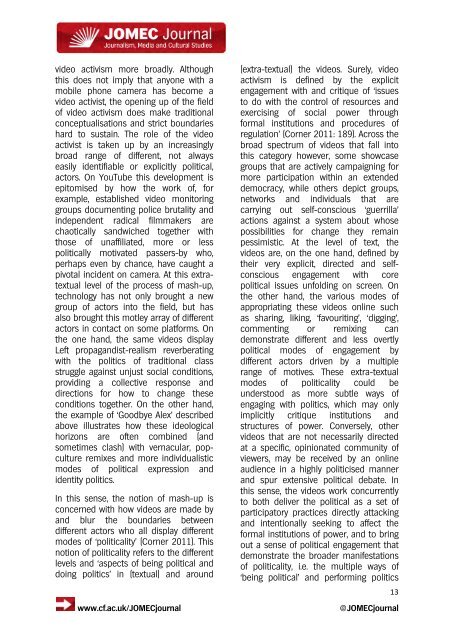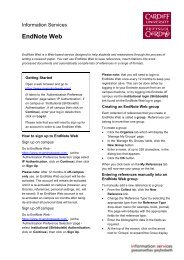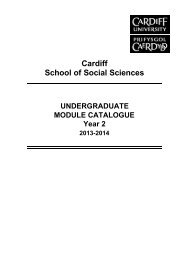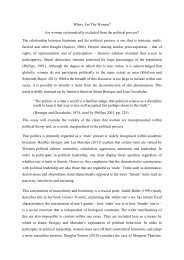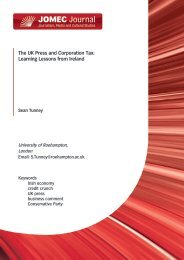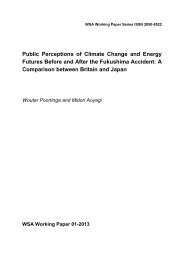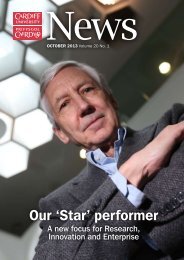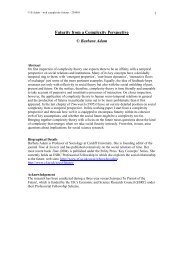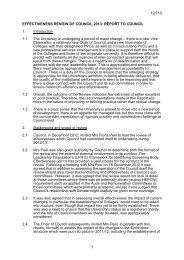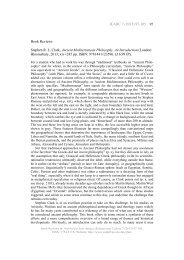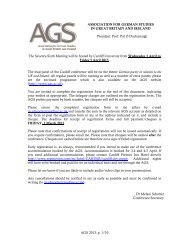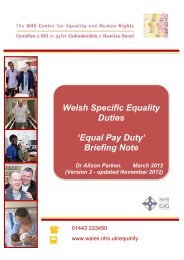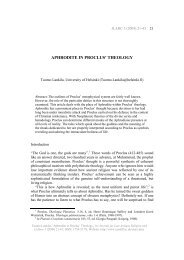Tina Askanius - Cardiff University
Tina Askanius - Cardiff University
Tina Askanius - Cardiff University
Create successful ePaper yourself
Turn your PDF publications into a flip-book with our unique Google optimized e-Paper software.
video activism more broadly. Although<br />
this does not imply that anyone with a<br />
mobile phone camera has become a<br />
video activist, the opening up of the field<br />
of video activism does make traditional<br />
conceptualisations and strict boundaries<br />
hard to sustain. The role of the video<br />
activist is taken up by an increasingly<br />
broad range of different, not always<br />
easily identifiable or explicitly political,<br />
actors. On YouTube this development is<br />
epitomised by how the work of, for<br />
example, established video monitoring<br />
groups documenting police brutality and<br />
independent radical filmmakers are<br />
chaotically sandwiched together with<br />
those of unaffiliated, more or less<br />
politically motivated passers-by who,<br />
perhaps even by chance, have caught a<br />
pivotal incident on camera. At this extratextual<br />
level of the process of mash-up,<br />
technology has not only brought a new<br />
group of actors into the field, but has<br />
also brought this motley array of different<br />
actors in contact on some platforms. On<br />
the one hand, the same videos display<br />
Left propagandist-realism reverberating<br />
with the politics of traditional class<br />
struggle against unjust social conditions,<br />
providing a collective response and<br />
directions for how to change these<br />
conditions together. On the other hand,<br />
the example of ‘Goodbye Alex’ described<br />
above illustrates how these ideological<br />
horizons are often combined (and<br />
sometimes clash) with vernacular, popculture<br />
remixes and more individualistic<br />
modes of political expression and<br />
identity politics.<br />
In this sense, the notion of mash-up is<br />
concerned with how videos are made by<br />
and blur the boundaries between<br />
different actors who all display different<br />
modes of ‘politicality’ (Corner 2011). This<br />
notion of politicality refers to the different<br />
levels and ‘aspects of being political and<br />
doing politics’ in (textual) and around<br />
www.cf.ac.uk/JOMECjournal<br />
(extra-textual) the videos. Surely, video<br />
activism is defined by the explicit<br />
engagement with and critique of ‘issues<br />
to do with the control of resources and<br />
exercising of social power through<br />
formal institutions and procedures of<br />
regulation’ (Corner 2011: 189). Across the<br />
broad spectrum of videos that fall into<br />
this category however, some showcase<br />
groups that are actively campaigning for<br />
more participation within an extended<br />
democracy, while others depict groups,<br />
networks and individuals that are<br />
carrying out self-conscious ‘guerrilla’<br />
actions against a system about whose<br />
possibilities for change they remain<br />
pessimistic. At the level of text, the<br />
videos are, on the one hand, defined by<br />
their very explicit, directed and selfconscious<br />
engagement with core<br />
political issues unfolding on screen. On<br />
the other hand, the various modes of<br />
appropriating these videos online such<br />
as sharing, liking, ‘favouriting’, ‘digging’,<br />
commenting or remixing can<br />
demonstrate different and less overtly<br />
political modes of engagement by<br />
different actors driven by a multiple<br />
range of motives. These extra-textual<br />
modes of politicality could be<br />
understood as more subtle ways of<br />
engaging with politics, which may only<br />
implicitly critique institutions and<br />
structures of power. Conversely, other<br />
videos that are not necessarily directed<br />
at a specific, opinionated community of<br />
viewers, may be received by an online<br />
audience in a highly politicised manner<br />
and spur extensive political debate. In<br />
this sense, the videos work concurrently<br />
to both deliver the political as a set of<br />
participatory practices directly attacking<br />
and intentionally seeking to affect the<br />
formal institutions of power, and to bring<br />
out a sense of political engagement that<br />
demonstrate the broader manifestations<br />
of politicality, i.e. the multiple ways of<br />
‘being political’ and performing politics<br />
13 <br />
@JOMECjournal


